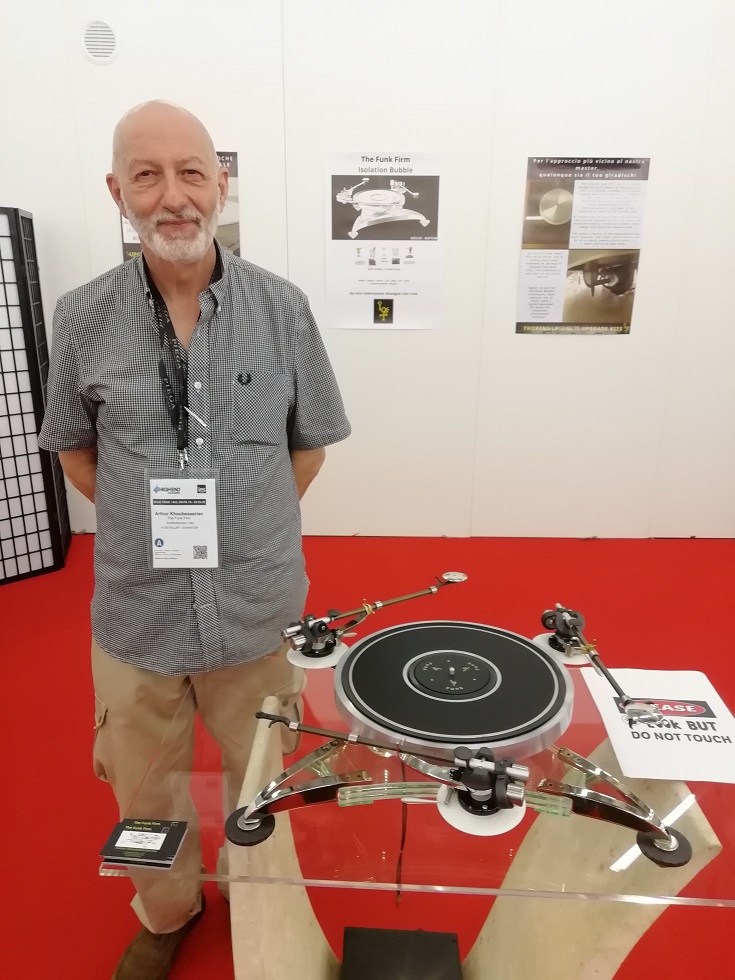
Reporter: Carlo Iaccarino
The show took place from May, 19th through May, 22th, 2022 at the M.O.C. facilities, in Munich, Germany
Originally written: May, 2022
Website with plenty of resources: High End Society
Let's re-start with something different, no, make that someone who thinks different. There's still space for companies that are the brainchild of real persons, in flesh and blood, rather than the expression of an impersonal board of managers. The company I'm about to discuss is the Funk Firm, by Arthur Khoubesserian.

Maybe my picture doesn't show it well, yet the first and foremost characteristic of his space was its vacuity. He paid the not small price for an exhibition space, just to exhibit... himself :-)
Actually, center stage was occupied by his latest turntable, the Kepler. He concentrated in it all his knowledge about the fight against vibrations, rotation stability, cartridge insulation, correct tracking, etc...
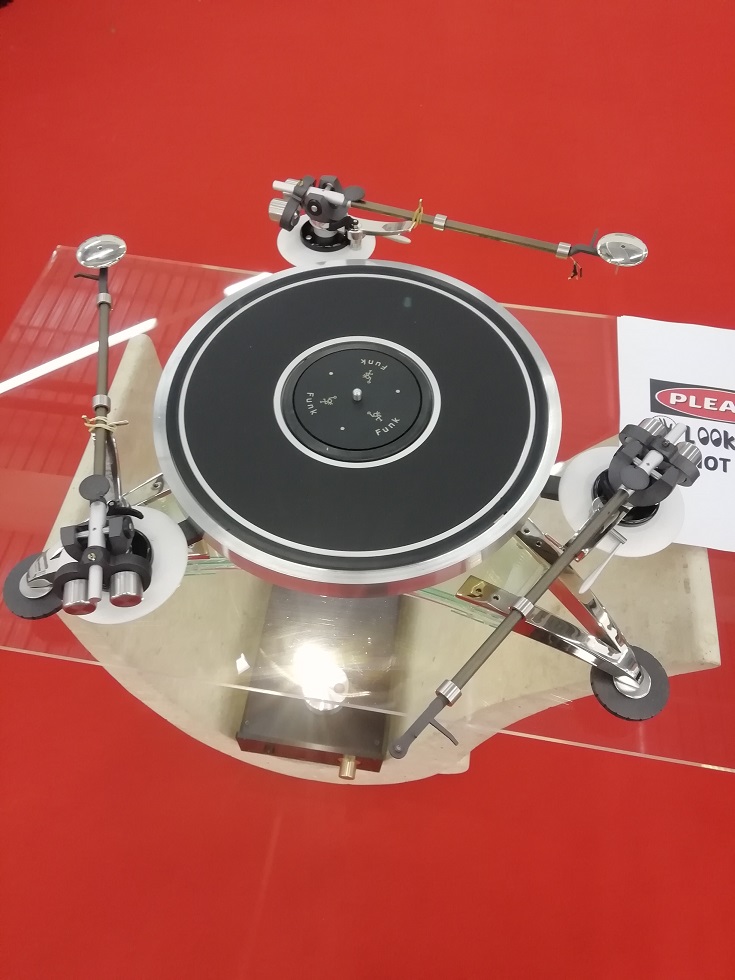
Here he mounted the latest model of his arms, the Raptor-z, but the models shown weren't complete, because he was waiting for the registration of the last of its five patents relative to the arm. In particular, this patent covers a solution to maintain a stable, dynamic stylus alignment, to reduce the tangential error along all the arc traced by the arm, not just in the usual two null-points. Very simplistically speaking, it works by having the shell rotate on the plane of the arm that holds it. It's quite like the old pantograph arms, but infinitely more precise and frictionless. Here is my goofy photo, intended to show turntable's structure and the arm.
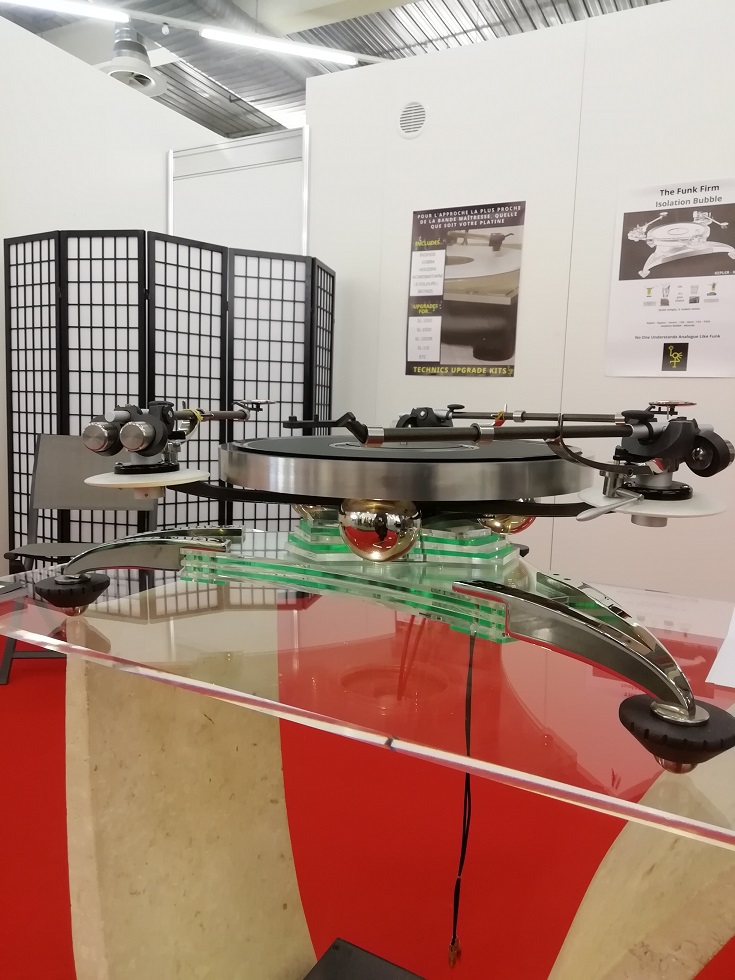
Naturally, there's much more going on, starting with the choice of the material for each piece - the frame, the platter, the armtube, and so on. On their website there's plenty of information, better and more precise than mine.
And yet, you will say, what's new about all of this? It's just another company stating they make the best turntable in the world.
That's not the case.
Khoubesserian was clear: answering to my remark that this was a rich man's turntable, he stated that it obviously was that, but it encapsulated, at their best, all his ideas about the correct way to design and realize the different parts of a system aiming to read a rotating disc. Those same ideas that his company - and here comes the interesting part - can easily apply also to turntables made BY OTHERS. In fact, the Funk Firm suggests a sort of modding for famous turntables or arms, to adapt them to incorporate their concepts. He is a big fan of modern Technics direct-drive motors - as much as the Kepler's motor is by Technics ("They do it very well, so, why can't we use them?") - and the Funk Firm proposes some interventions on the mythical "twelvehundred" regarding its platter, its arm, its isolation base, that apply lots of the company's ideas. It's just because they think they are universal solutions to problems common to every turntable, problems intrinsic to the reading of a spinning record. Not only that: they also sell modifications for Rega turntables and they dare to revisit Linns, too.
Judging from all the information he passed to me, I met a person who is passionate about this topic and firm in his belief, based on the results he has gained from experimentation. Consider that the two walls defining his space were covered with posters showing the oscillograms "before and after" Funk Firm treatments were applied to turntables, arms and cartridges by other makers. Maybe, also for this he was somewhat critical of British (should I have written Scottish? :-) ) analogue "mainstream" companies. My chat with Khoubesserian was long, fun, and educative, and I thanked him a lot - and I do it here once more - for the time he dedicated to un unknown irker wearing the TNT-Audio hat. Sure, if, instead, our Editor were there to ask questions, maybe we could have ended up with an interesting interview... ;-)
Let's remain in the analog domain, but move along more common paths.
Also this year there was the traditional "Vinyl Square" by Pro-Ject, the giant Austrian company who pioneered the vinyl resurgence and that now offers a complete and varied range of turntables, besides a wide range of electronics and loudspeakers, so that it is now possible to assemble a whole system under the Pro-Ject brand.
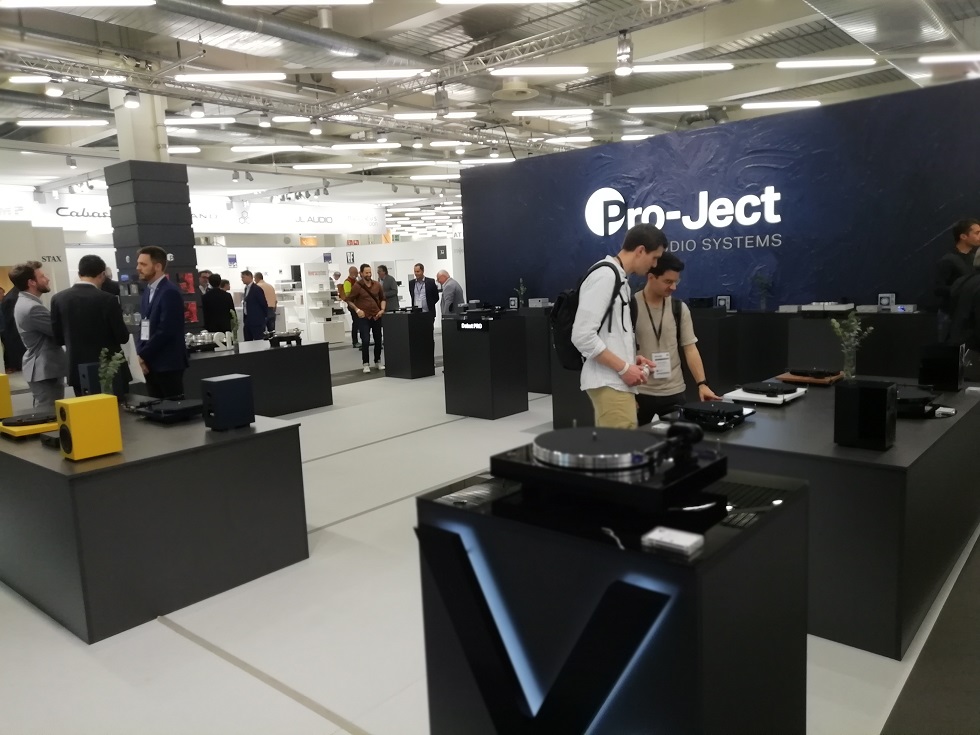
This company now offers all kind of products, and showed in their Square the models they were more confident with. To start with something simple and not-so-serious,
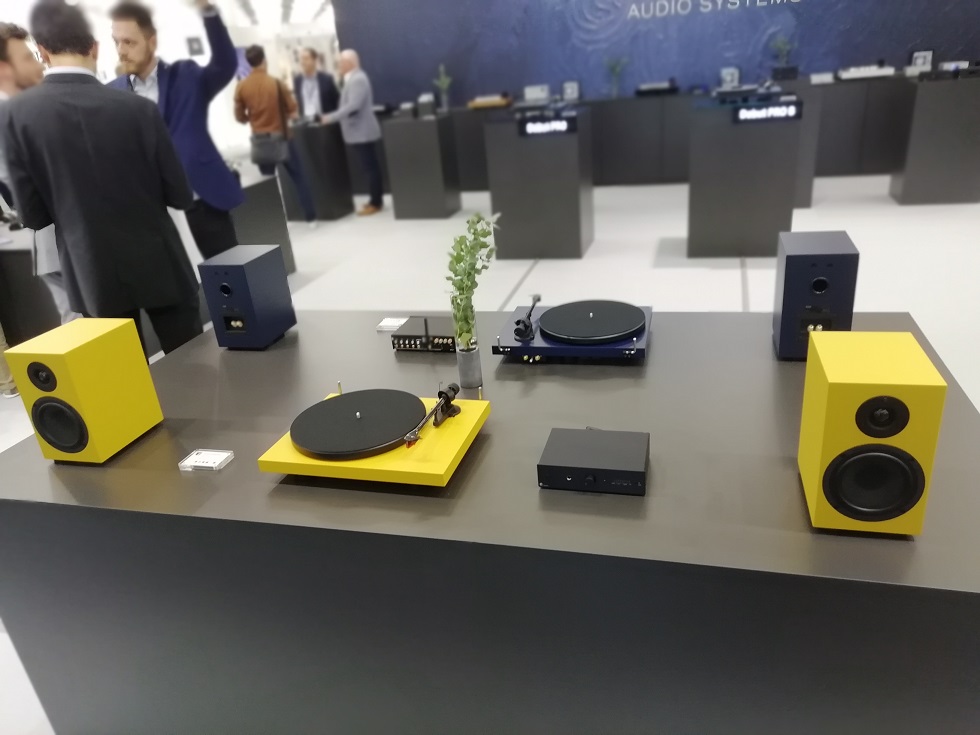
namely the special edition turntable, the Metallica, honoring that famous hard rock band,
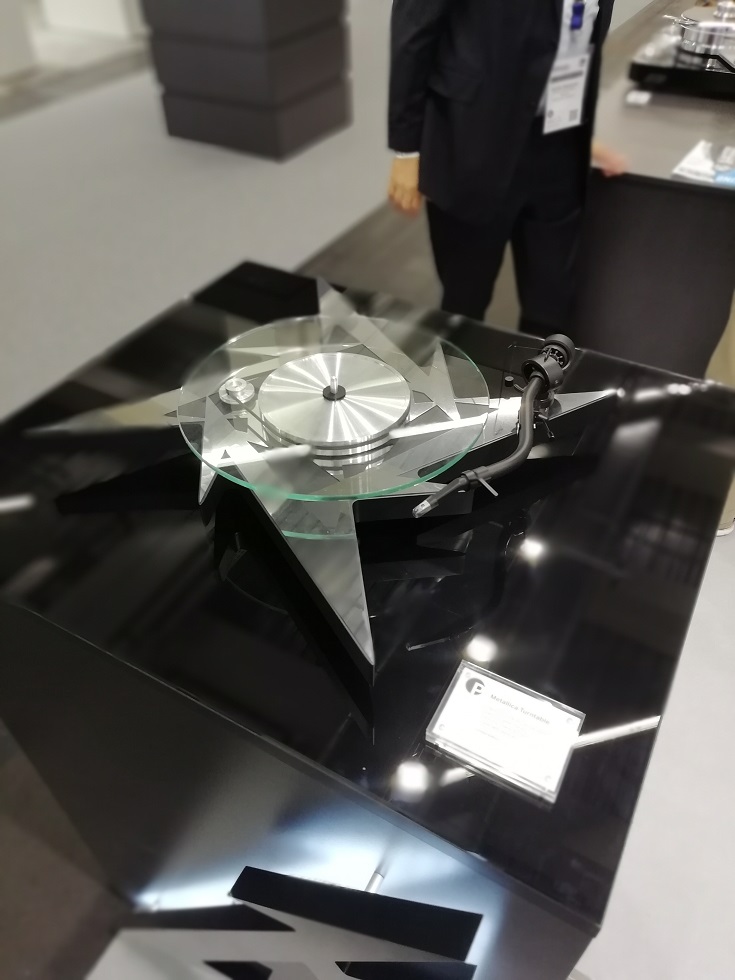
to commemerative editions of top-of-the-line gear: here we have a special version of the
Signature 12
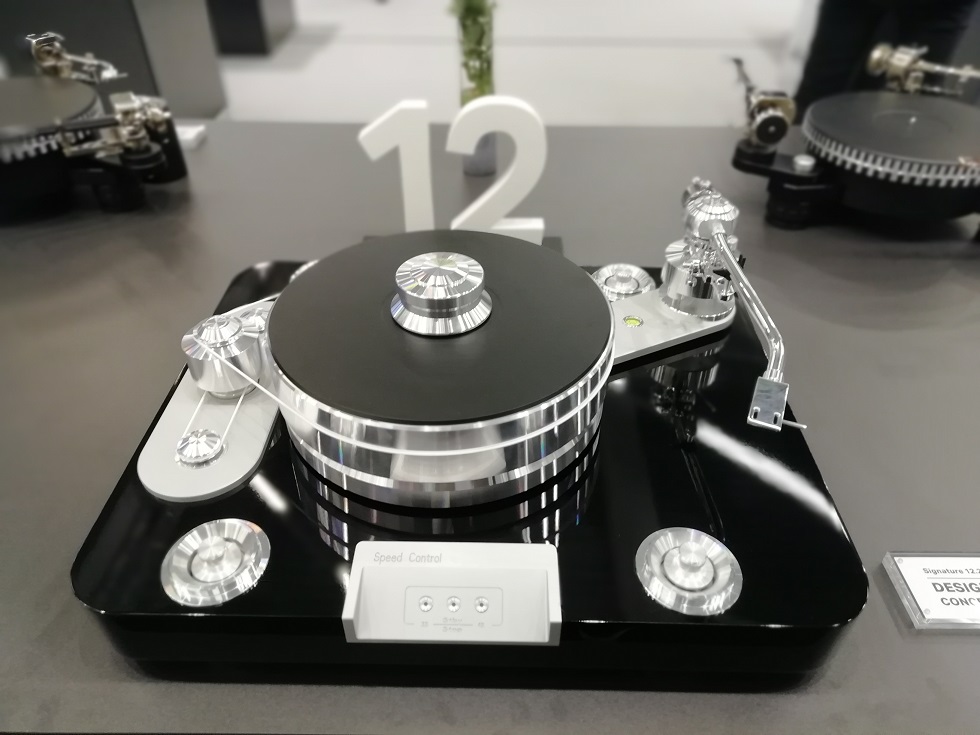
and here is a special version of the RPM 12
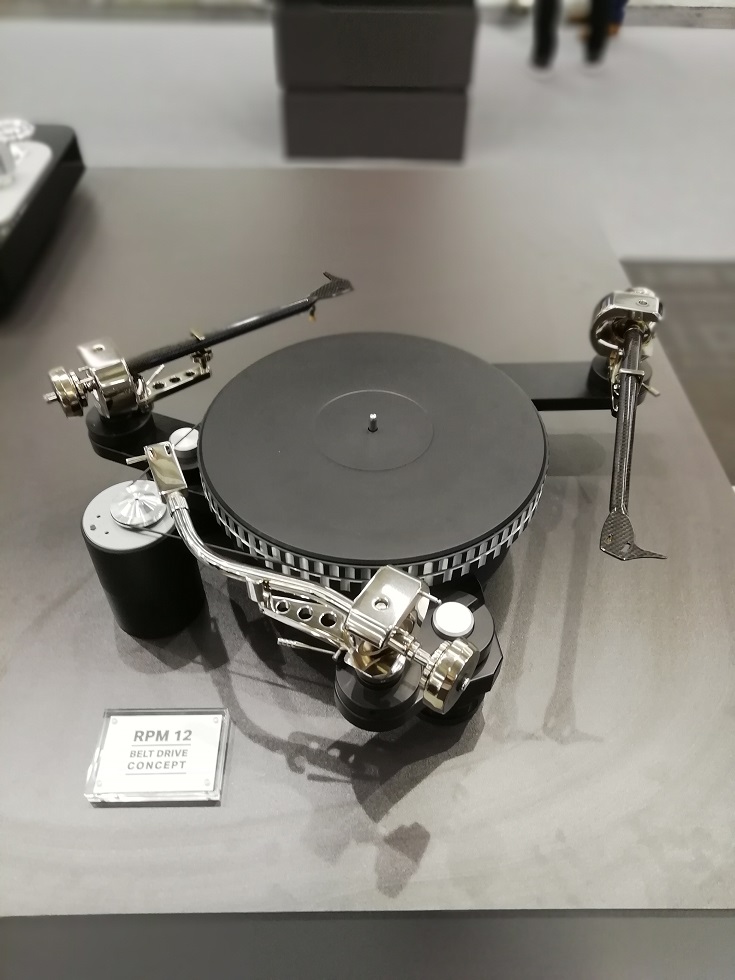
Surely many of you will know that Pro-Ject is bonded (also through marriage) to EAT, a company that also produces turntables, but dedicated towards the highest levels of the market. Here we have an impressive parade of the best of EAT's models and of Pro-Jects top-of-the-line turntables. On a colorful note, in the picture you can see also a "negotiating table" (let's not forget that this show starts as a place for B2B meetings) with the evergreen Roy Hall with one of his unmissable Scottish partners, ideal to make people agreeable and conciliatory :-)
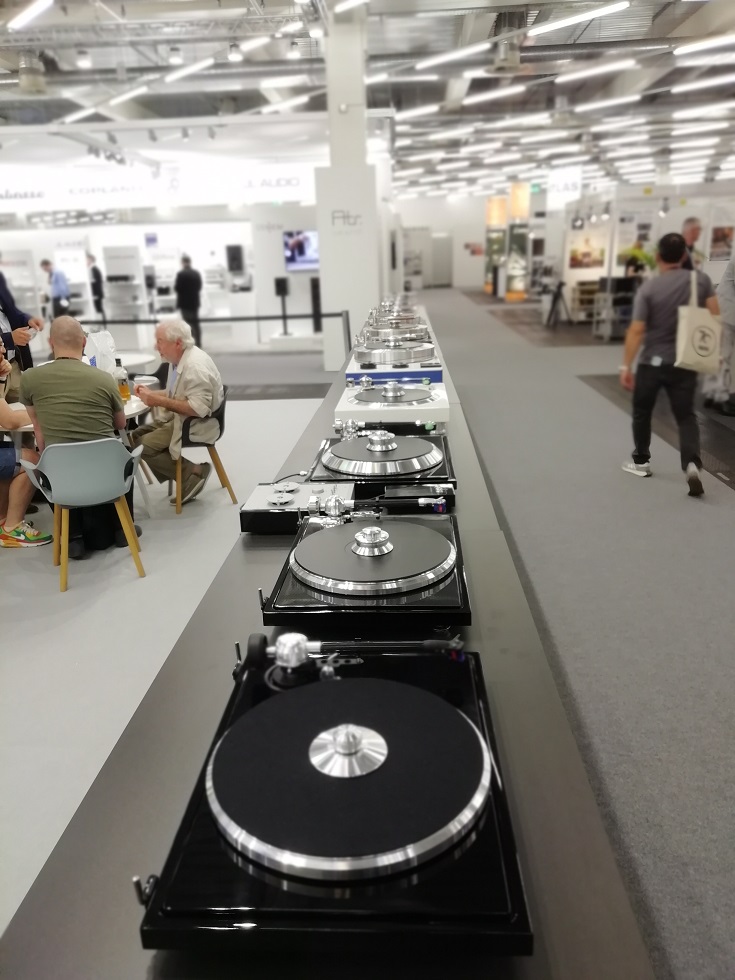
There were also Pro-ject's electronics. The attention was drawn by the new version of their MM and MC pre-phono Phonobox RS2.
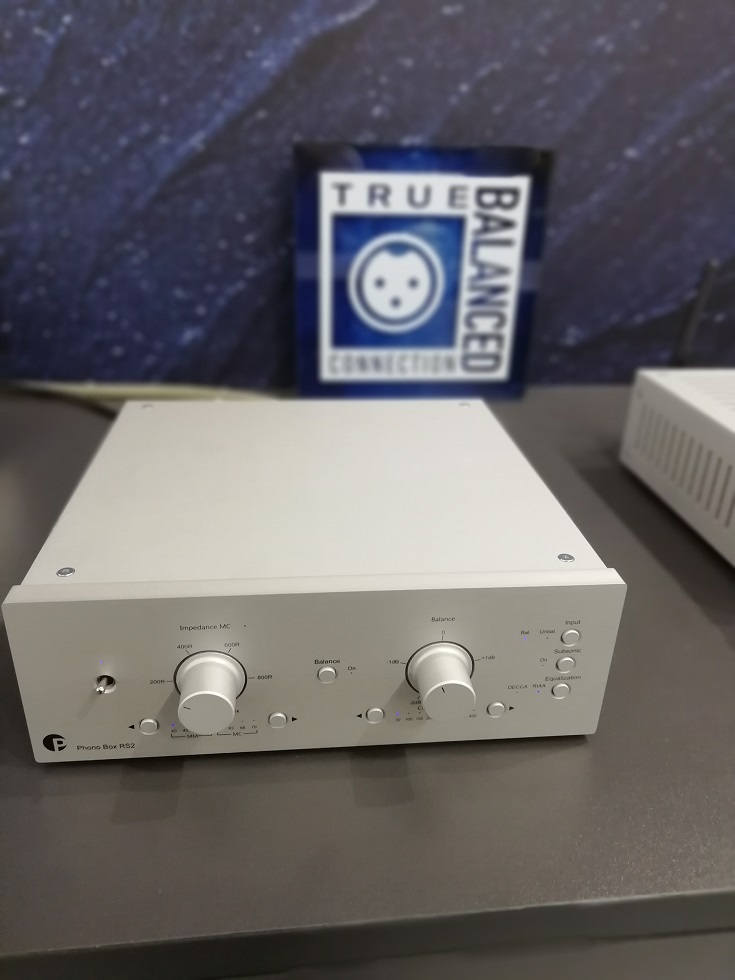
It allowed for a great versatility for coupling to a variety of cartridges, and, above all, for its balanced circuitry.
Actually, from what I know, the cartridge signal is generated as a balanced one and then it gets unbalanced along the path - like when you connect to ground the negative leg of one channel (if i didn't misunderstand it, it's a problem that MCs don't suffer). This piece of gear allows to keep the signal balanced even after preamplification and RIAA de-emphasis, so that it can be delivered to an amplifier that, too, can be balanced. This way you are assured that the signal is treated in balanced mode from the system's start to its end. That should reward you with lesser noise, thus better dynamics.
Clearaudio couldn't miss this show, either. It's the main German producer of not only turntables and cartridges, but also of electronic devices and records. Also this company believes in the benefits of going balanced when dealing with the cartridge signals, and this year they were debuting their Balance reference phono balanced pre-phono.
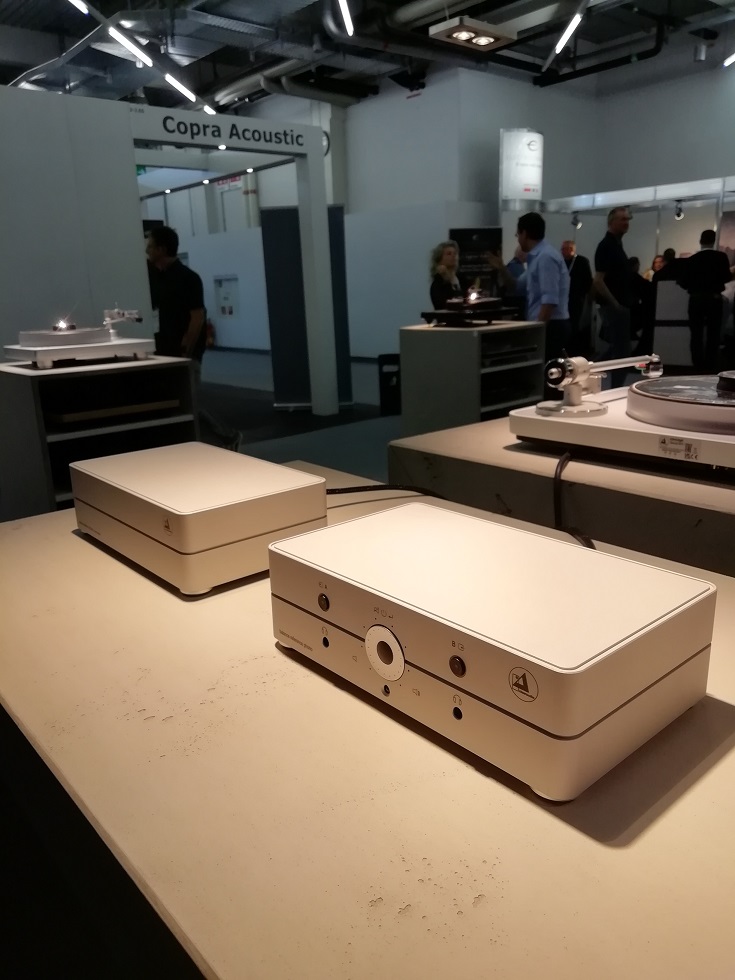
This pre-phono comes in two boxes, one containing its dual mono power supply, connected by an umbilical cord. It has two inputs, each one present in balanced and unbalanced version, that can accept MM and MC cartridges; it has also one output, this, too, either balanced or unbalanced (so this device can work also as a balanced/unbalanced format converter).
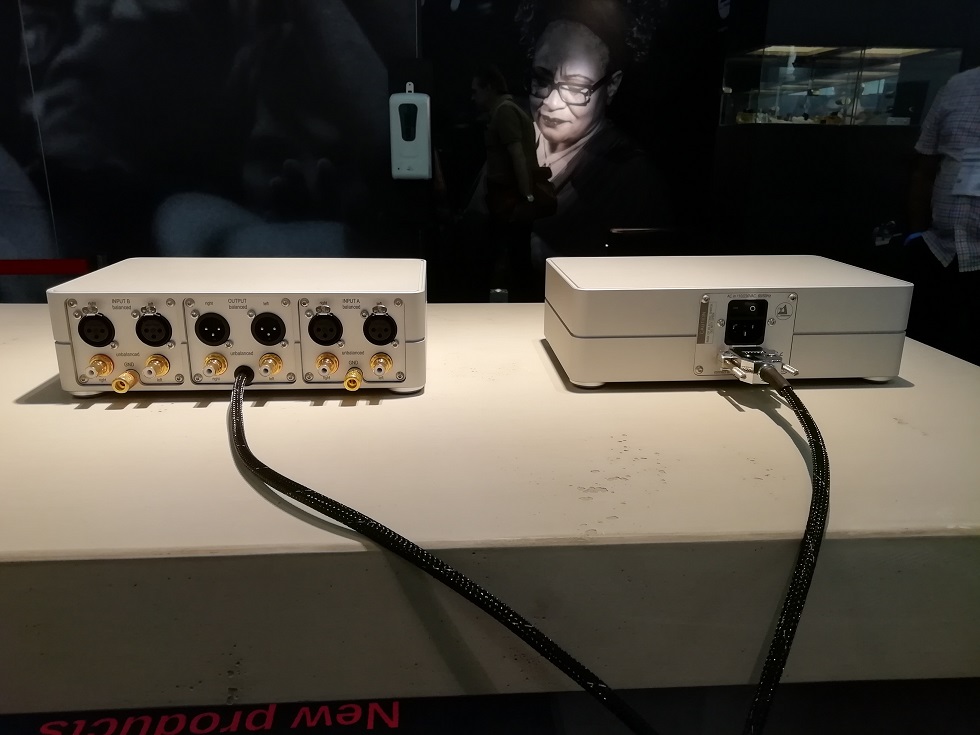
Moreover, it has a refined volume control (here comes again the idea that it must be connected to a loudspeaker that has "inside" everything else needed to play). On the front you also find the input switches and two headphone outputs. Everything for about Eur 8.000. You can have it in any color you want, provided it's black or white :-)
Naturally, Clearaudio also had its "Vinyl Square",
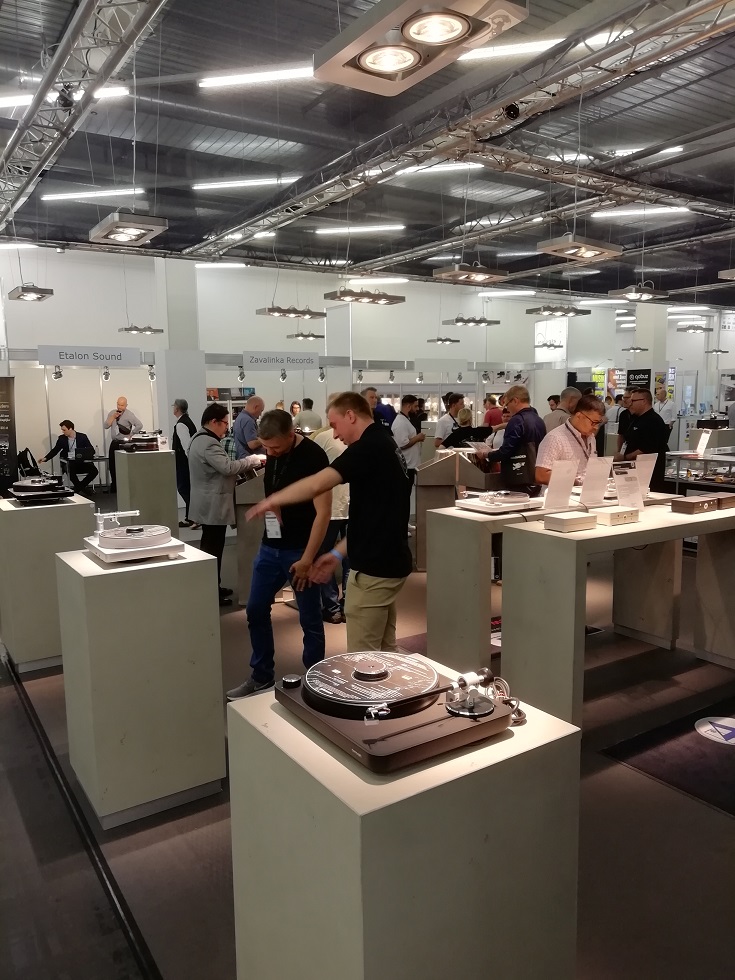
and a part of it was dedicated to the turntable series developed around the same plinth concept, shaped like the base on which they were exhibited.
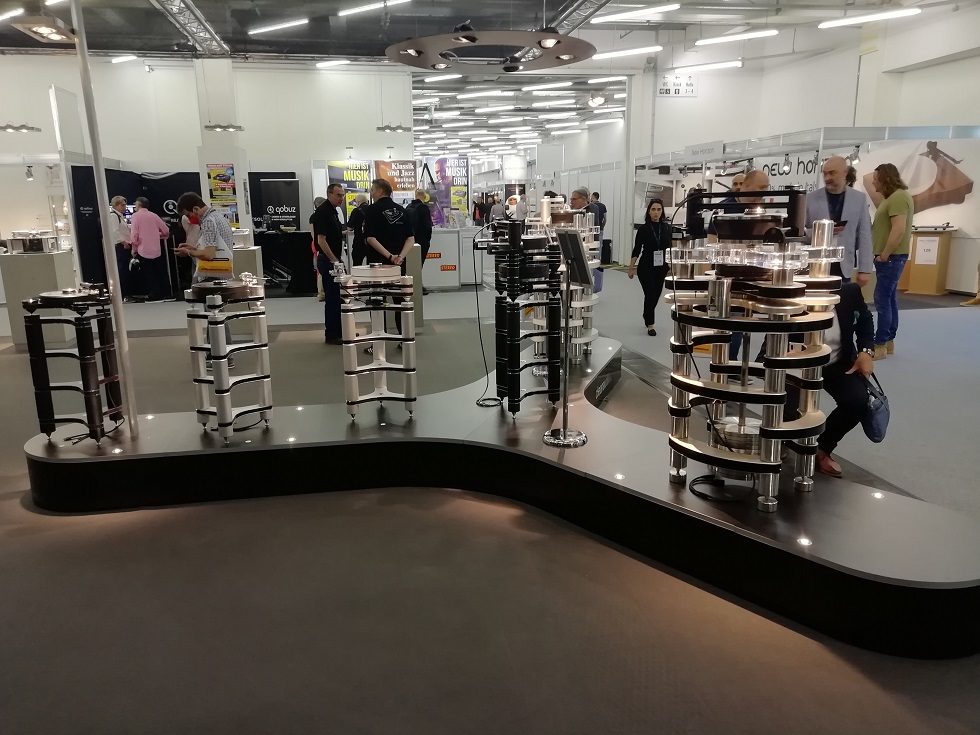
As I wrote, besides turntables, there were vinyl records, too,
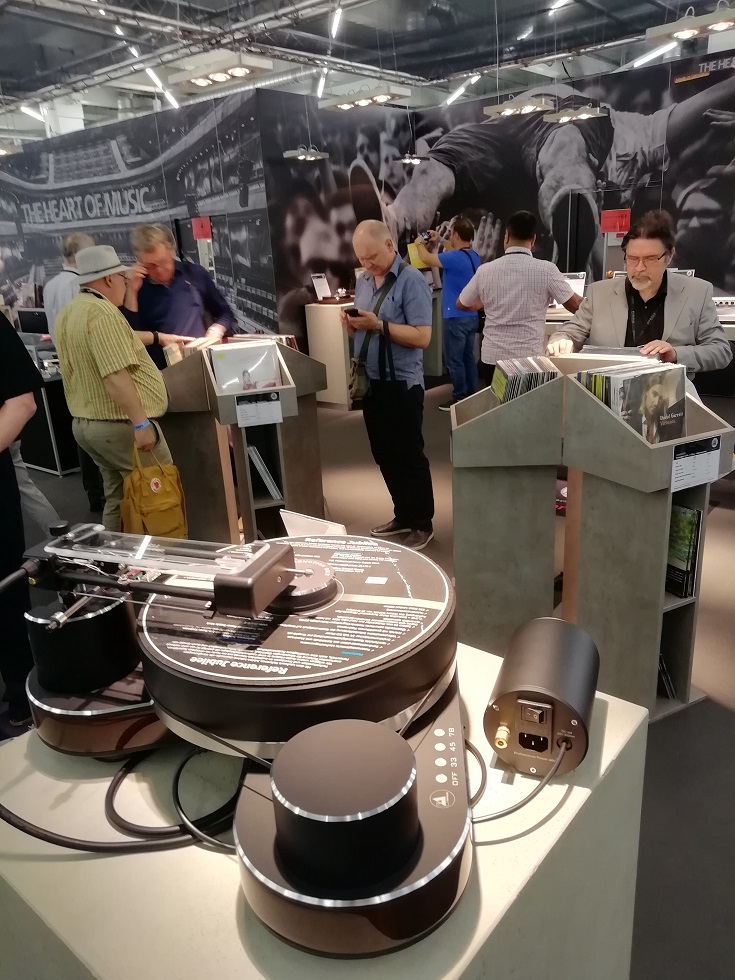
cartridges,
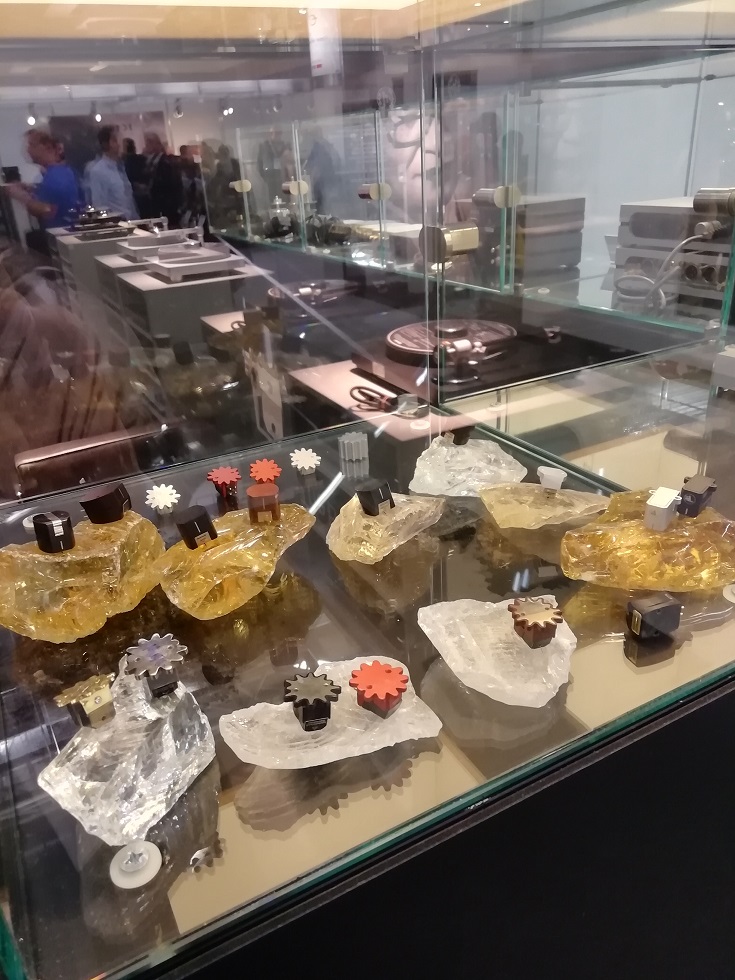
and also some hint at a different way to present one's analog gear. An easier way, comfortable and aesthetically acceptable also in a living room of normal people. You know, the kind of people that go like " How can you tolerate the presence of all those boxes? and those wires...". In a single word, for a lifestyle listening mode. Sincerely, I don't think it's a bad idea to try and recuperate these devices (I'd say, this activity) from the audiophile ghetto in which they are usually considered. Or, to see a half-full glass, we audiophiles are able to enjoy a higher quality of sound reproduction in the homes of everyday people we visit :-)
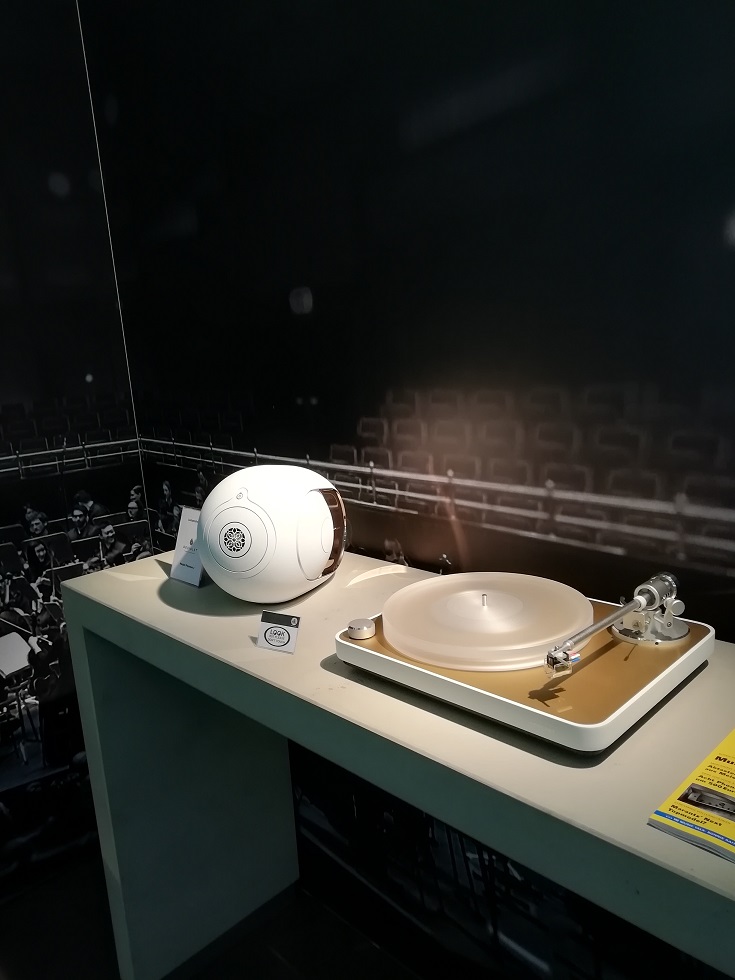
Now, it's Thorens' turn.
This traditional turntable producer, too, this year bet on the balanced treatment of the signal coming from the cartridge. According to Agatha Christie, "3 pieces of an evidence" make a certainity... They brought to the show their TPP 1600 (price tbd), a preamplifier featuring a modular configuration. Depending on the mounted boards, you can add up to 4 phono inputs and 4 line inputs, either balanced or unbalanced. I shot an awful picture of its front, but an explicit picture of its innards.
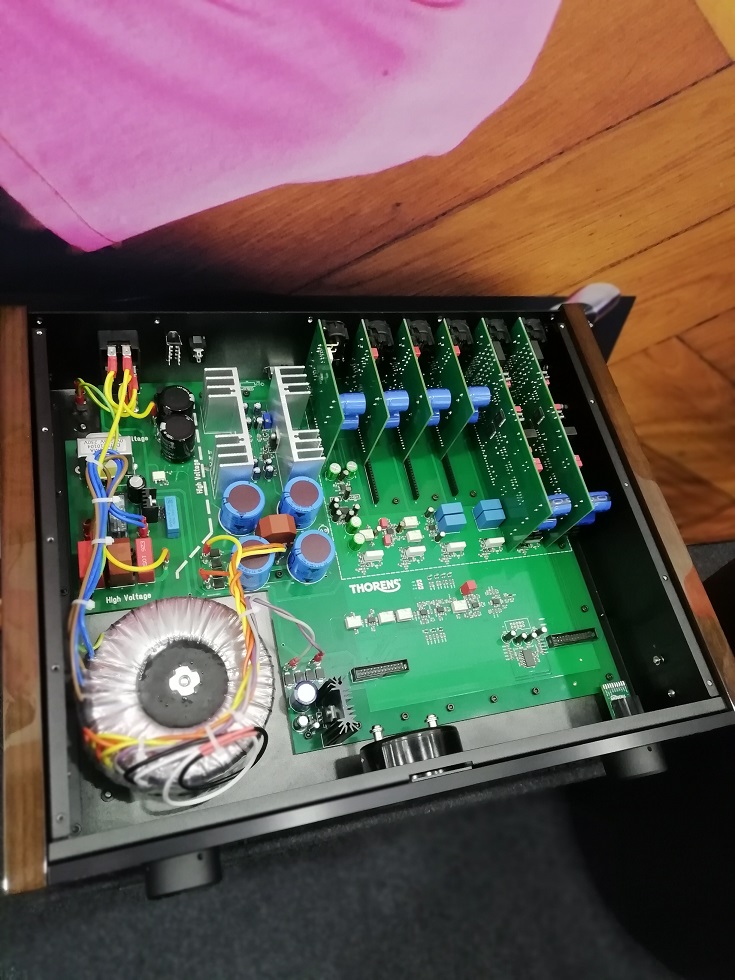
It has an unbalanced output and a balanced one. On its front you can find the headphone output. Its pre-phono features include, besides the usual interface value controls, an indicator to regulate (or, rather, electrically compensate for) the Azimuth. Besides RIAA de-emphasis, it supports also Decca and Columbia curves. There you have a sneak view of its back panel:
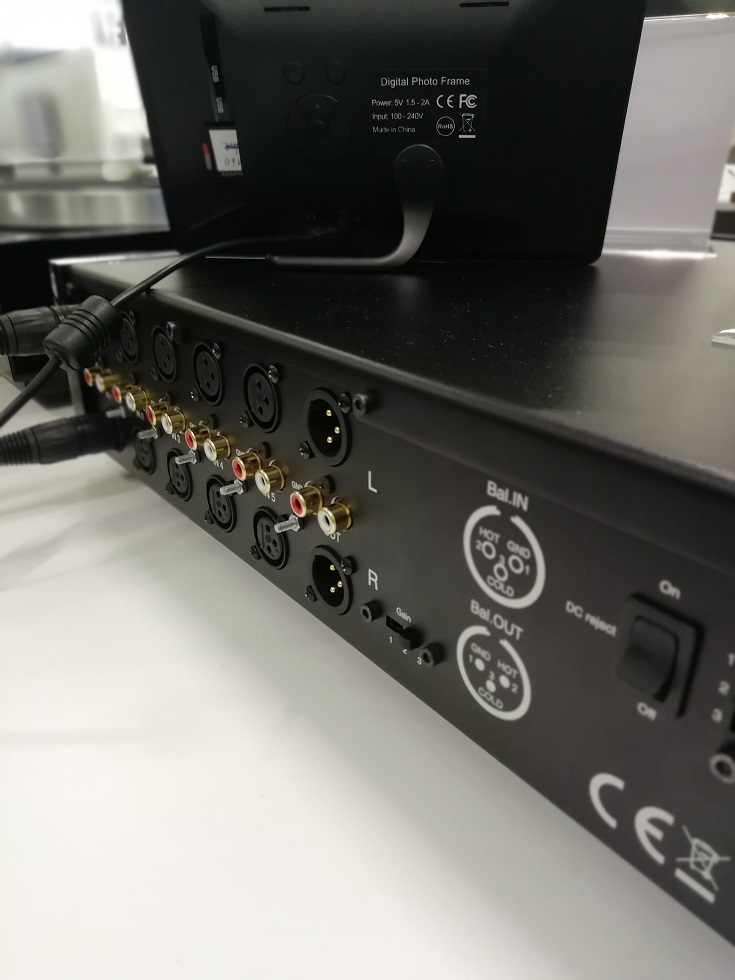
Its perfect match is the TD 1601 turntable (for about Eur 3.300), which sports balanced outputs. Here it's pictured aside its homologous TD 1600 turntable (for about Eur 2.800) sporting only unbalanced outputs. They both feature a floating chassis and an arm from Thorens' new series.
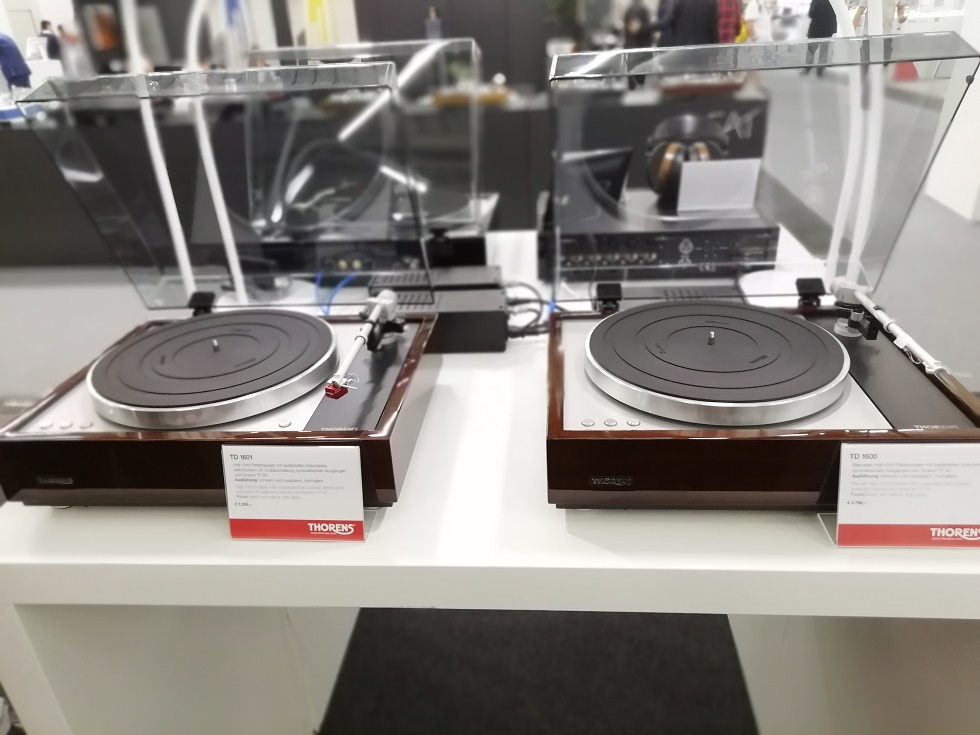
Another turntable with similar characteristics (floating chassis and new arm) brought to the show was the TD 1500 model (for about Eur 2.000).
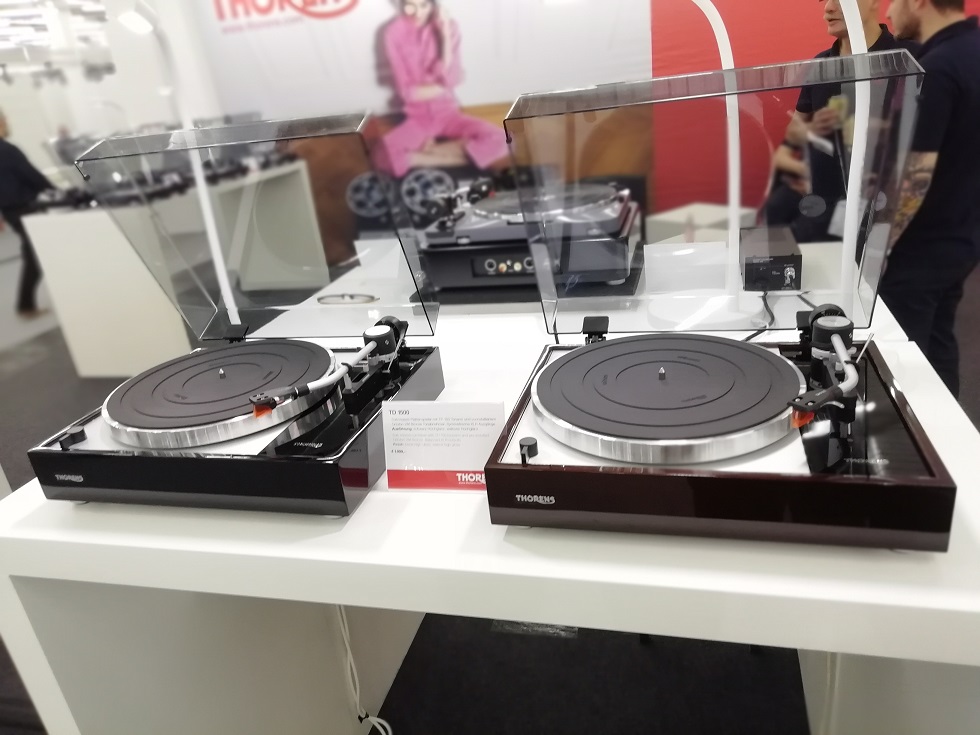
Obviously, they couldn't miss the "new edition" of the famous TD 124... That's now called TD 124 DD, where that double D tells us that the drive is now direct, and not via a pulley anymore. It surely functions very well; it even won the EISA award ... but it still seems a bit strange... Anyway, here it is, righteously left alone on its throne.
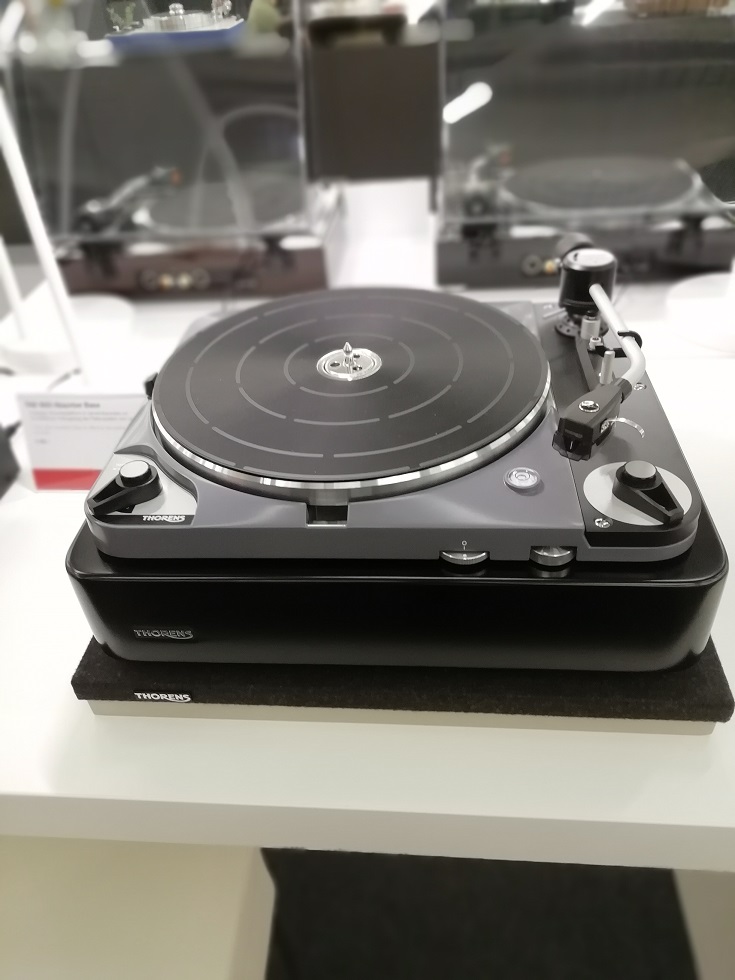
Jumping to another pond, here we go with another exhibition I really liked: Dynaudio's.
To celebrate its first 45 years (I told you, lots of celebratory dates, this year), this company setup a huge exhibition space, showing all its ranges. There you go with some hints, starting with a partial collective photo.
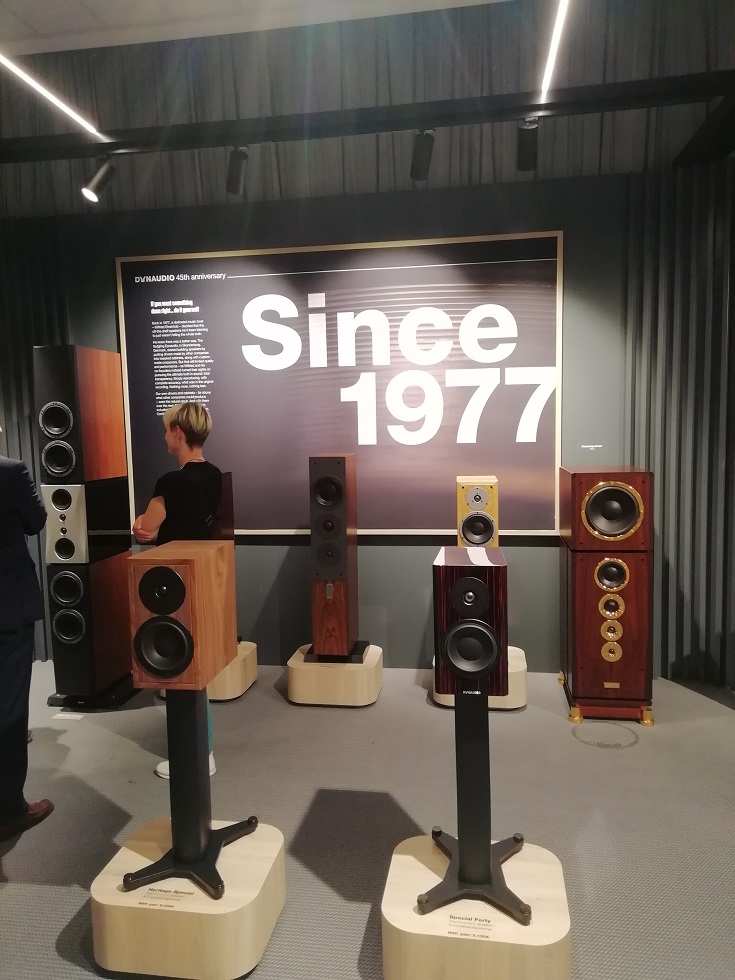
Here is the Evoke range,
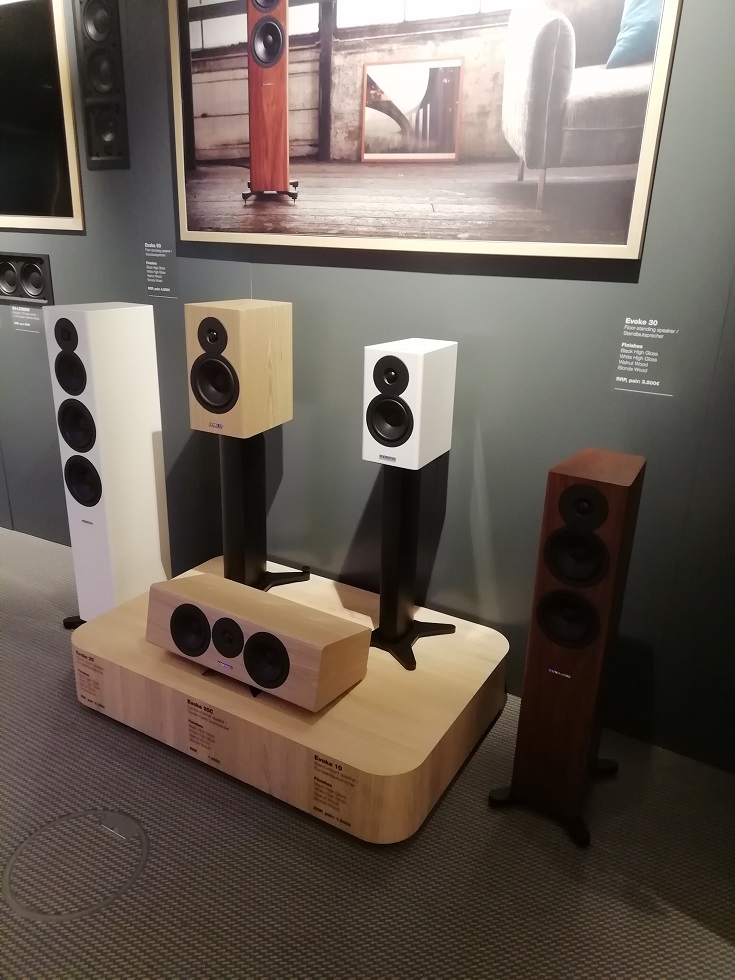
then, there's the Confidence range,
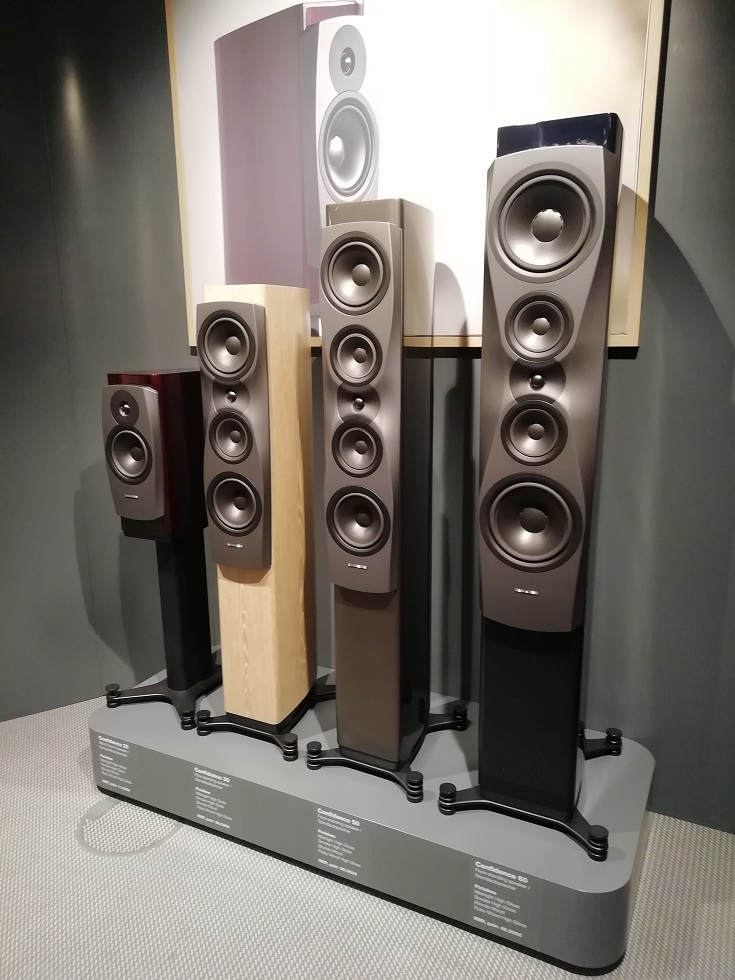
the Emit range,
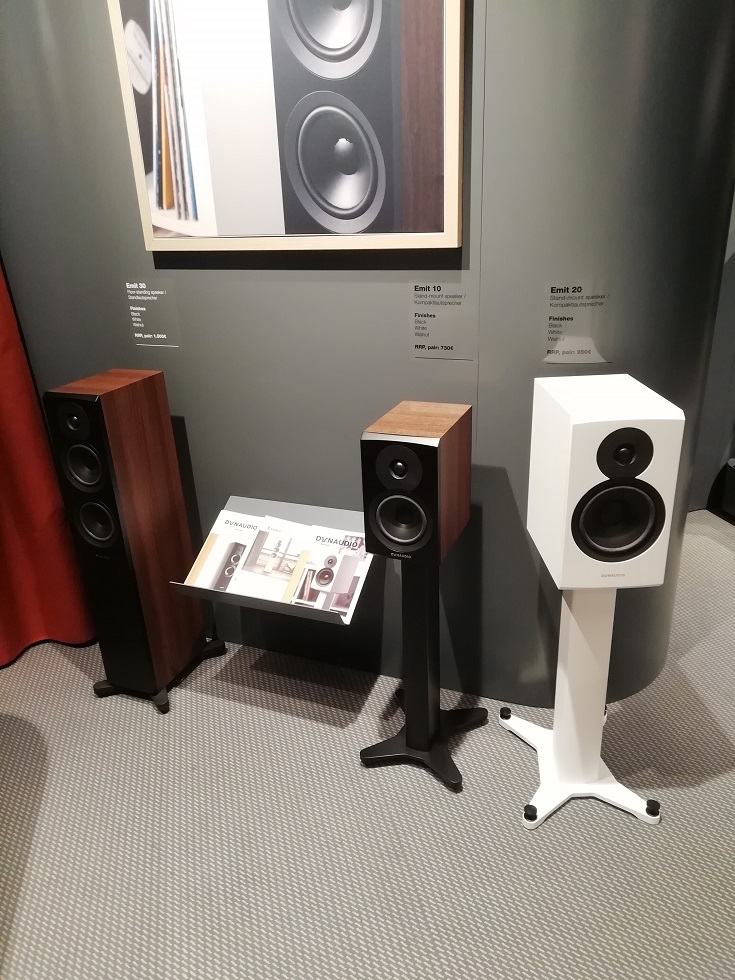
and the new Focus range, where we once again find that concept of "all in one" loudspeaker I wrote before. They are loudspeakers that are not only amplified, but also featuring digital inputs (so, they have a DAC inside) and LAN connections (so, they have also a streamer inside).
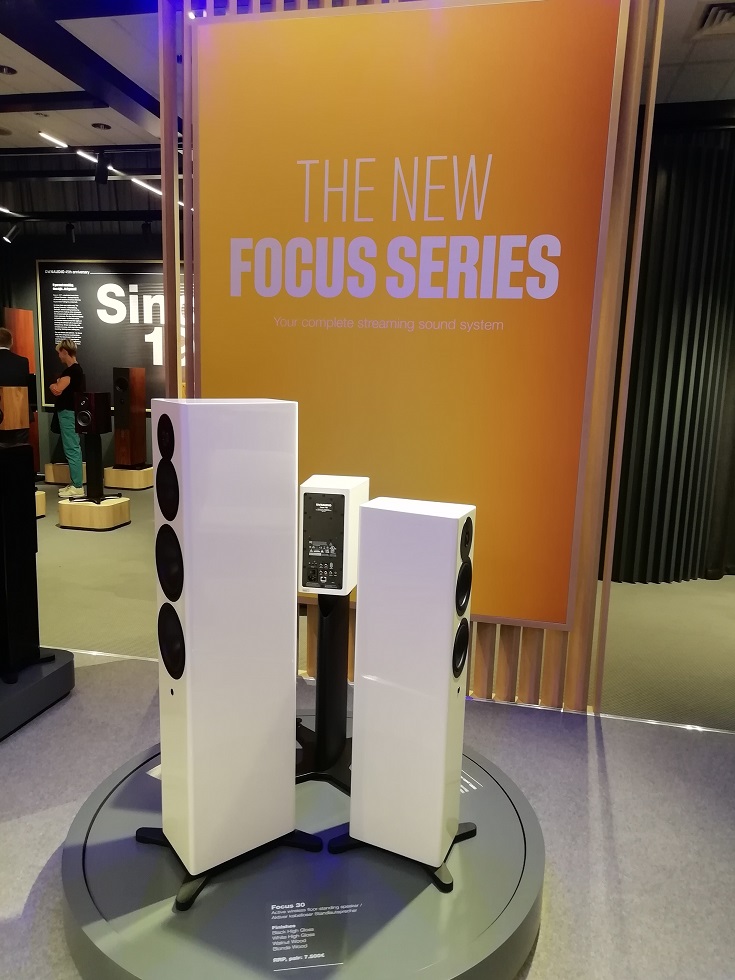
I attended the long demonstration about this range, and it was crowded, as well as the one that preceded it and the one that followed it.
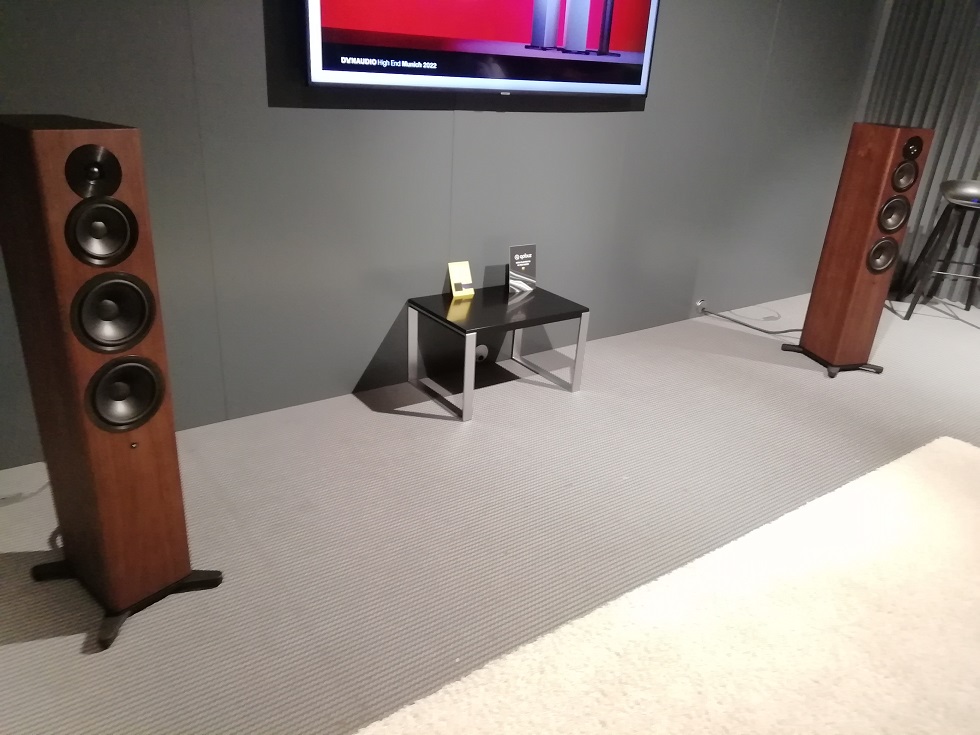
I hope my picture can give well the main idea: THE WHOLE SYSTEM CONSISTS OF TWO LOUDSPEAKERS, and the only "wire" you see is the power cable. You connect them to your AC outlet and to your wifi network, and you are ready to stream your music (for the demo the were streaming music from Qobuz, but they could also stream local files from their NAS...). I think this is the direction our hobby is taking.
Some more details. These loudspeakers are amplified (they use PASCAL switching amplification modules) and are of the sealed box type. They use as streaming platform, the Stream Unilimted 810x. All the pieces that perform the processing of the incoming digital data are synchronized using the same clock. Unlike other streaming solutions, here there are no parts that work at their own clock speed (and so, along the digital chain, there would have to take place calculations for converting signals in order to allow the dialogue, for instance, between a section that works at 48 kHz and another one that works at 88.2 kHz). Here, instead, we have a synchronization that adapts to the incoming signal, that will decide which will be the clock for all the subsequent parts of the chain. This, besides affording less audio loss due to the absence of conversion issues, allows also for a perfect lip-sync for audiovisual applications. These loudspeakers are WISA certified, ad are an open system, unlike many other competitors, who use proprietary protocols to make their loudspeakers talk between them and the external world. Finally, they are also DIRAC Live ready: as an accessory, you can buy a calibrated microphone and a license for the DIRAC Live software. Prices? the standmount model 10 costs about Eur 5.000, the little tower 30 about 7.500, and the biggest tower 50, the one they used for the demo, costs about Eur 10.000. They seem steep prices, but, remember that this is the actual price of a whole system, and a very technologically up-to-date one; and for what I could hear at the show, even good sounding.
JBL, too, pointed towards system integration and presented their 4305 P active monitor, whose aesthetics remind a lot the classic monitors from California of... some decades ago. Unfortunately, the company's website is not exactly easy to navigate, maybe due to the mess of consumer products under the JBL brand, maybe for the vastness of its parent company, the Harman Group, maybe for the enormity of the operation field of its parent (grandparent?) company, Samsung. So, I can only direct you towards the webpage of this specific product.
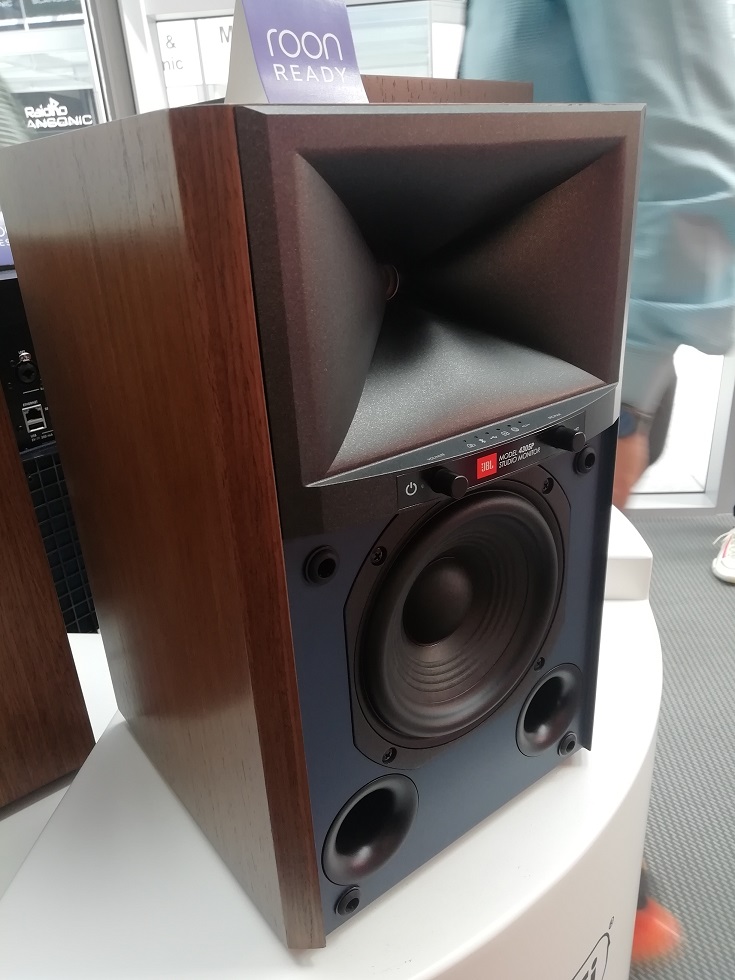
It is a two-way loudspeaker, with internal multiamplification (2 x 150 W); it can act as a streamer; it is Roon ready, it can connect to anything and can "read" streams from Qobuz and Tidal; it also has Chromecast functions; its internal DAC has high resolution capabilities. Everything for about Eur 2.200.
It is a little bookshelf, but with a big voice, and wasn't afraid to play a fairly big room (in the past years, that's where KEF held its demonstrations).
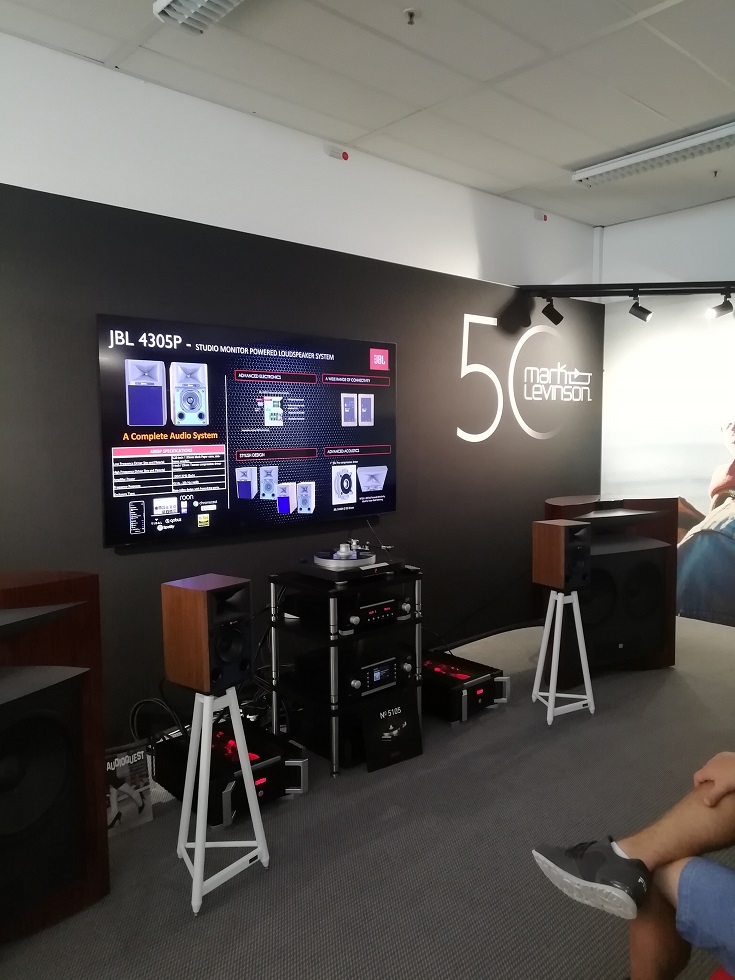
Of course, music was different when the JBL's bigger siblings were called on, powered by the new Mark Levinson monoblocks made to celebrate (I told you...) this brand's first 50 years (c'mon, don't be sad if you happen to perfectly remember when their first preamplifier debuted, then the ML-2, and then Curl, and Colangelo...). Yet, I felt the 4350P's "firepower" was notable, and above all, never "yelled" or "got in your face".
I'd like to finish my descriptions with another demonstration that I really liked, the one by Moon.
This year they produced their first - and, as far as they told me, destined to remain only for some time - loudspeaker, the Voice 22.
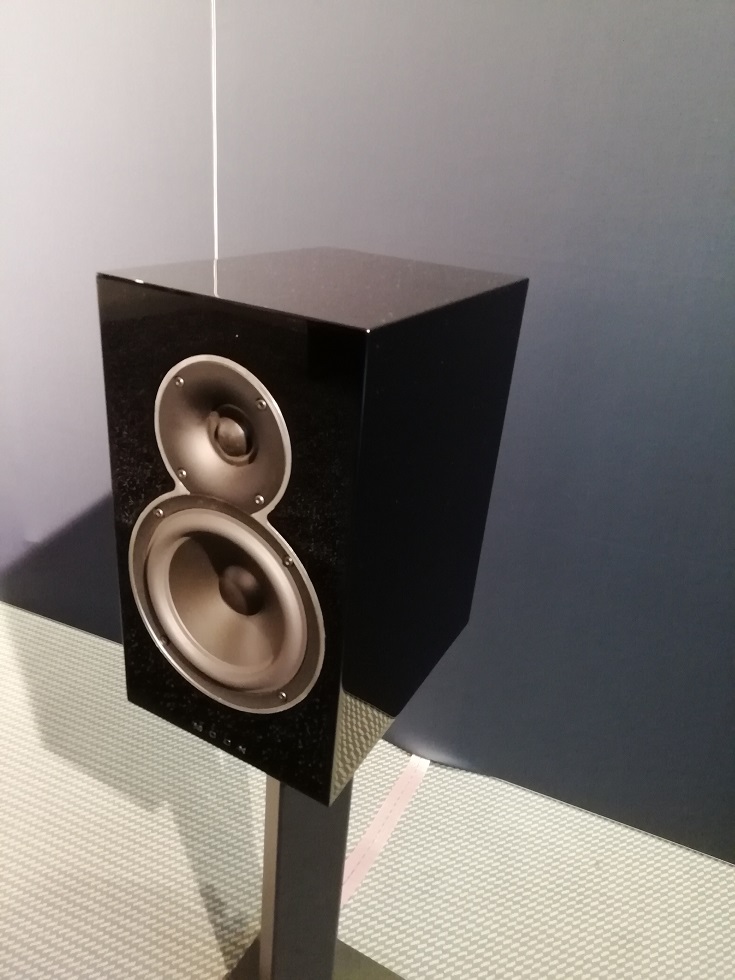
They purposedly didn't attempt to create a "flagship" beast to complete their famous - and expensive - amplifier line. They produced a very normal two-way standmount loudspeaker: a classic solution intended to enter anyone's house, potentially driven by amplifiers even lesser than Moon's own.
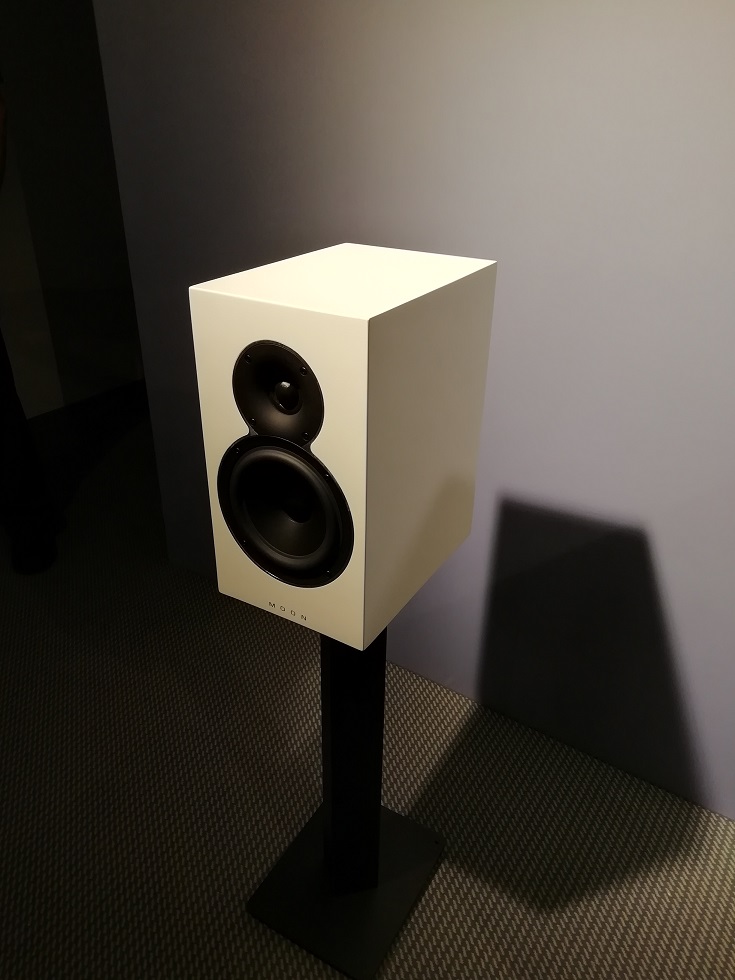
Their space, anyway, used their own electronic devices, but it was minimalist: here is the "big rig".

It consisted of the 390 preamplifier/DAC/streamer (once again, an all-in one), for less than Eur 7.000, and the 330, a stereo power amp, for about Eur 5.000. That's it.

The "little" system was even more "integrated", matching the Voice 22 with the ACE, an integrated amplifier with DAC and streamer capabilities for around Eur 3.000.
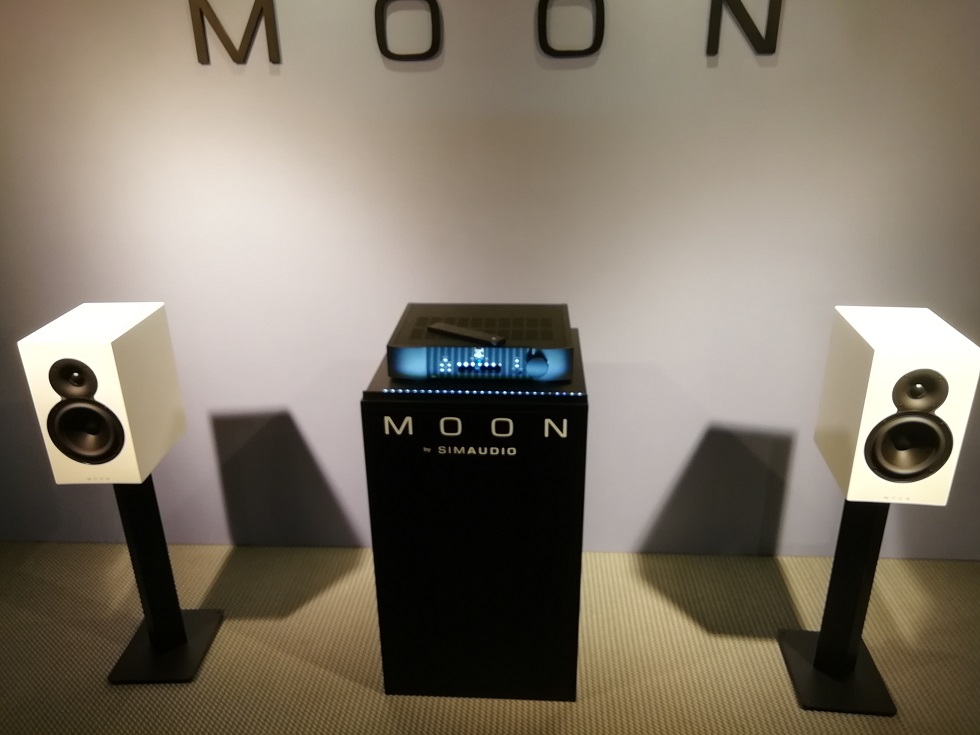
Moon's hall was wide, but the little Voice 22 filled it well. In this case, too, without screaming, without being "in your face", but with calm delicacy. No miracle, no slaughtered giants, here, but lot of enjoyability. I'm looking forward to reading their forthcoming reviews in the mainstream magazines...
I have many more photos and stories to share with you, but not as much time, so, once again, I must stop for now. But I'll be back.
In the meantime, here's the link to the first part. Fast forward to Part III.
DISCLAIMER. TNT-Audio is a 100% independent magazine that neither accepts advertising from companies nor requires readers to register or pay for subscriptions. If you wish, you can support our independent reviews via a PayPal donation. After publication of reviews, the authors do not retain samples other than on long-term loan for further evaluation or comparison with later-received gear. Hence, all contents are written free of any “editorial” or “advertising” influence, and all reviews in this publication, positive or negative, reflect the independent opinions of their respective authors. TNT-Audio will publish all manufacturer responses, subject to the reviewer's right to reply in turn.
© Copyright 2022 Carlo Iaccarino - www.tnt-audio.com
[ Home | Staff & Contacts | HiFi Playground | Listening tests | DIY & Tweakings | Music & Books ]